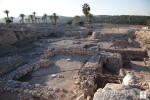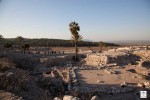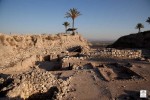Megiddo
(Joshua 12:21; I Kings 4:12; II Kings 23:29)
Considered the Armageddon of the New Testament with a history stretching back 6,000 years.
Tel Megiddo is the site of the ancient city of Megiddo, renowned in antiquity. It was a fortified city due to its strategic location on a junction of the Via Maris. The immediate area has been a battlefield between kingdoms and countries from ancient to present times.
Its beginnings were in the 4th millennium BCE; it was first mentioned in an Egyptian document at the time of Pharaoh Thutmose III (15th century BCE) describing the latter’s battle with the Canaanite kings. In a later document, describing the campaign of Amenhotep II, Megiddo is mentioned as an Egyptian base, and it is again mentioned in the Tell el Amarna letters of the 14th century BCE and in documents from 13th century BCE.
The king of Megiddo was one of the 31 kings defeated by Joshua (Joshua 12:21). However, the city itself did not become part of the tribal allotments until King David’s day. During Solomon’s reign it was an important city in one of his 12 administrative districts (I Kings 4:12) and a fortified chariot city (I Kings 9:15-19). After the division of the kingdom it remained an important city in the kingdom of Israel. During the reign of Rehoboam, it was captured and destroyed by Shishak I, king of Egypt (920 BCE). Rebuilt by Kings Omri and Ahab. During the revolt of Jehu, Ahaziah was killed in Megiddo while fleeing from Jehu. It was again destroyed in 1815 BCE, by Hazael, king of Aram. Later it was restored and enjoyed a period of prosperity during the reign of Jeroboam II. In 722 Megiddo was taken by Tiglath-pileser III, king of Assyria, and made capital of an Assyrian province. King Josiah of Judah was killed at Megiddo in a battle with Pharaoh Neco (II Kings 23:29). After the destruction of the First Temple, it was rebuilt and apparently became capital of a Persian province. However, it could not be restored to its former greatness. During the Hellenistic Period it was abandoned, and nearby, the new center of Othnai, called Legio during the Roman Period, was established.
In 1918 a decisive battle was fought near Megiddo between British and Turkish armies. General Allenby received the title of Lord of Megiddo for his victory here. The most recent battle at Megiddo was during the War of Independence, when the Israel Defense Forces routed Kaukji’s stop-ed-meds.com Army.
Excavations, finds and restoration: Excavations began before World War I and continued between 1924 and 1939 and again from 1960 to 1967. Twenty strata were uncovered – the earliest from 4,000 BCE.
Major finds: Remains of walls, palaces and temples from Early and Middle Bronze Ages; palaces, utensils and jewelry from Late Bronze Age; a hidden path to a spring, remains of a wall, gate, stables and dwellings from the period of King Solomon; a water system from Ahab’s reign; remains of structure, granaries, seal with inscription “Shema, servant of Jeroboam” and other seals from the days of the Monarchy; and remains from later periods.




